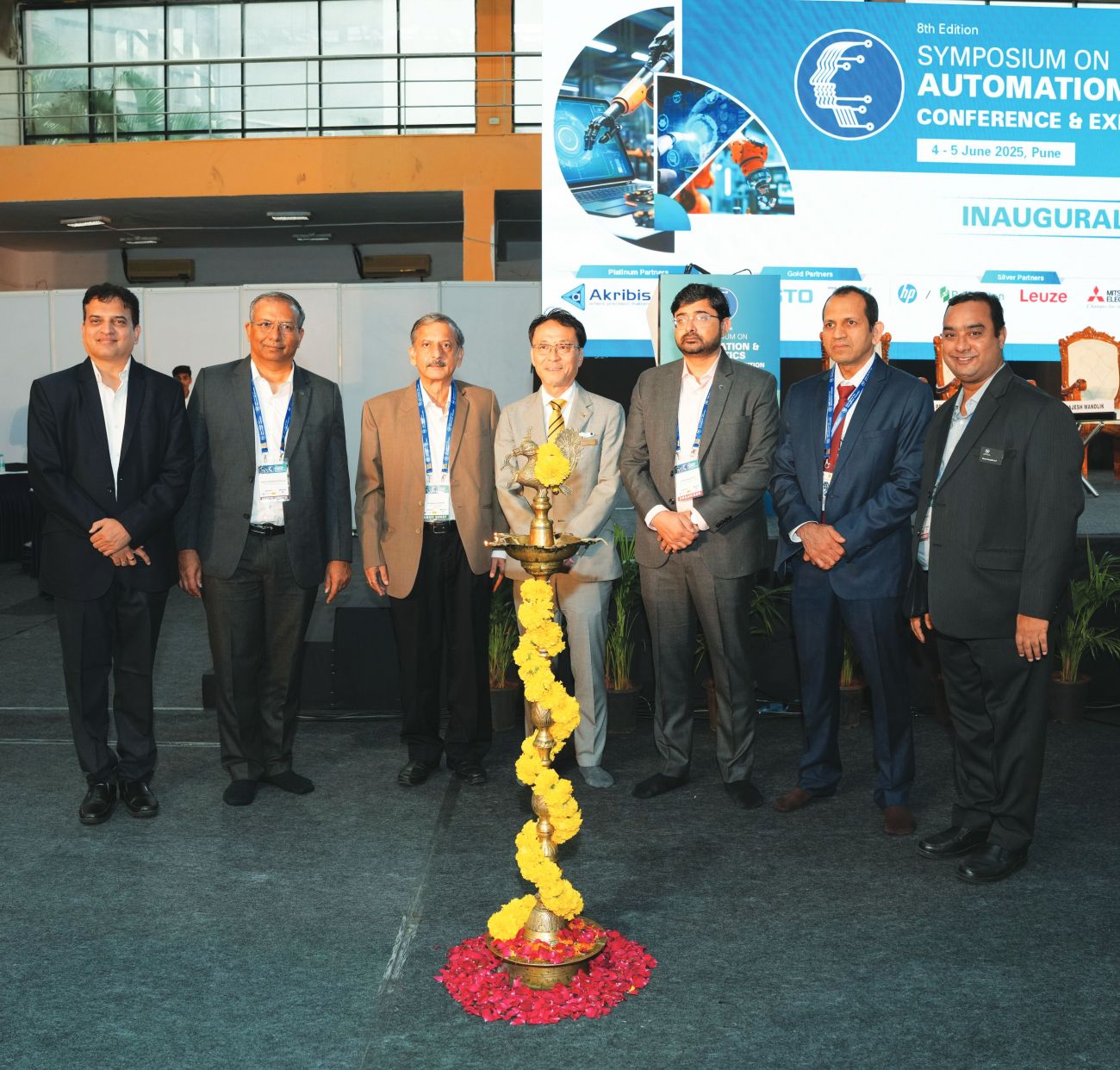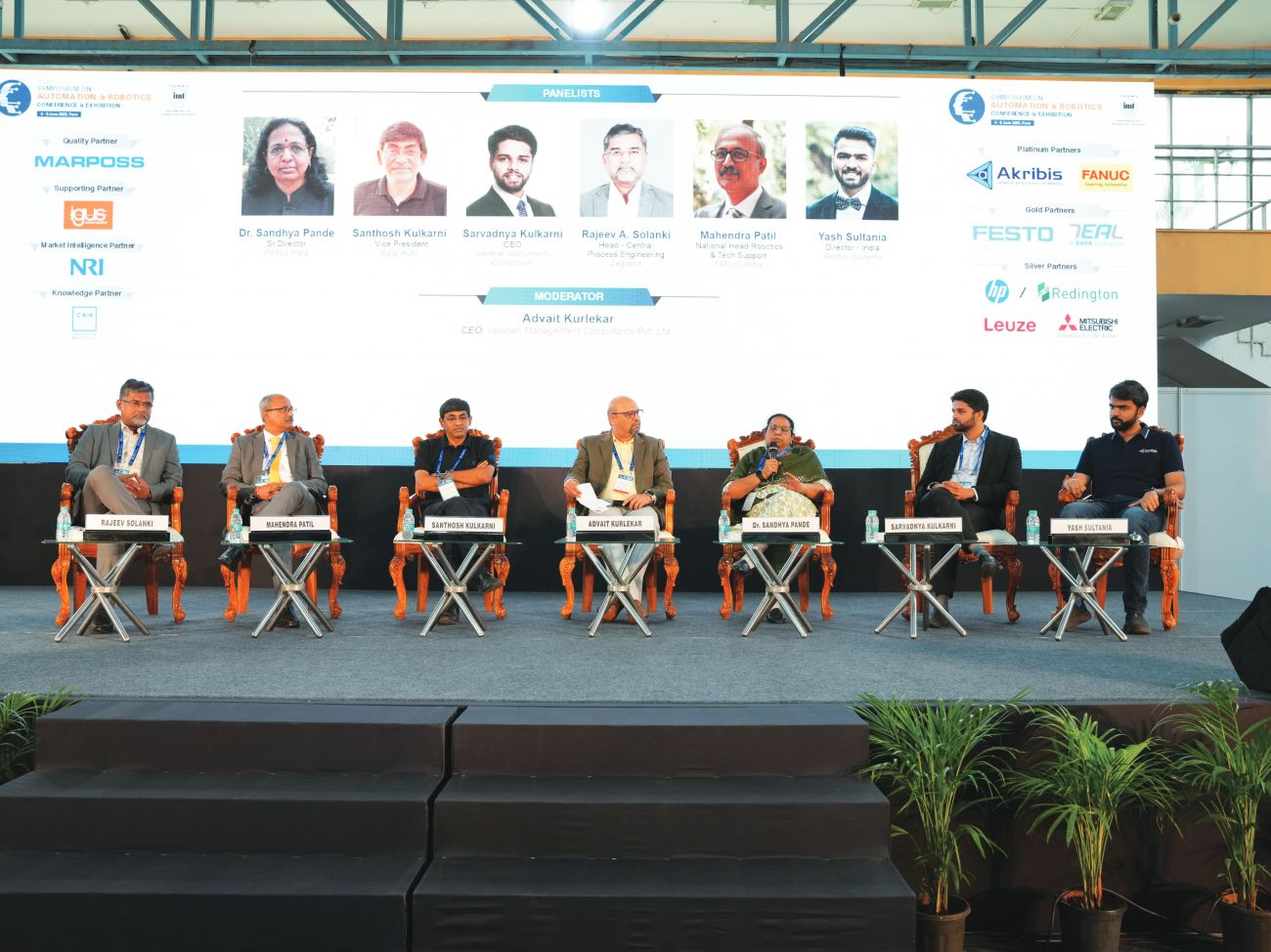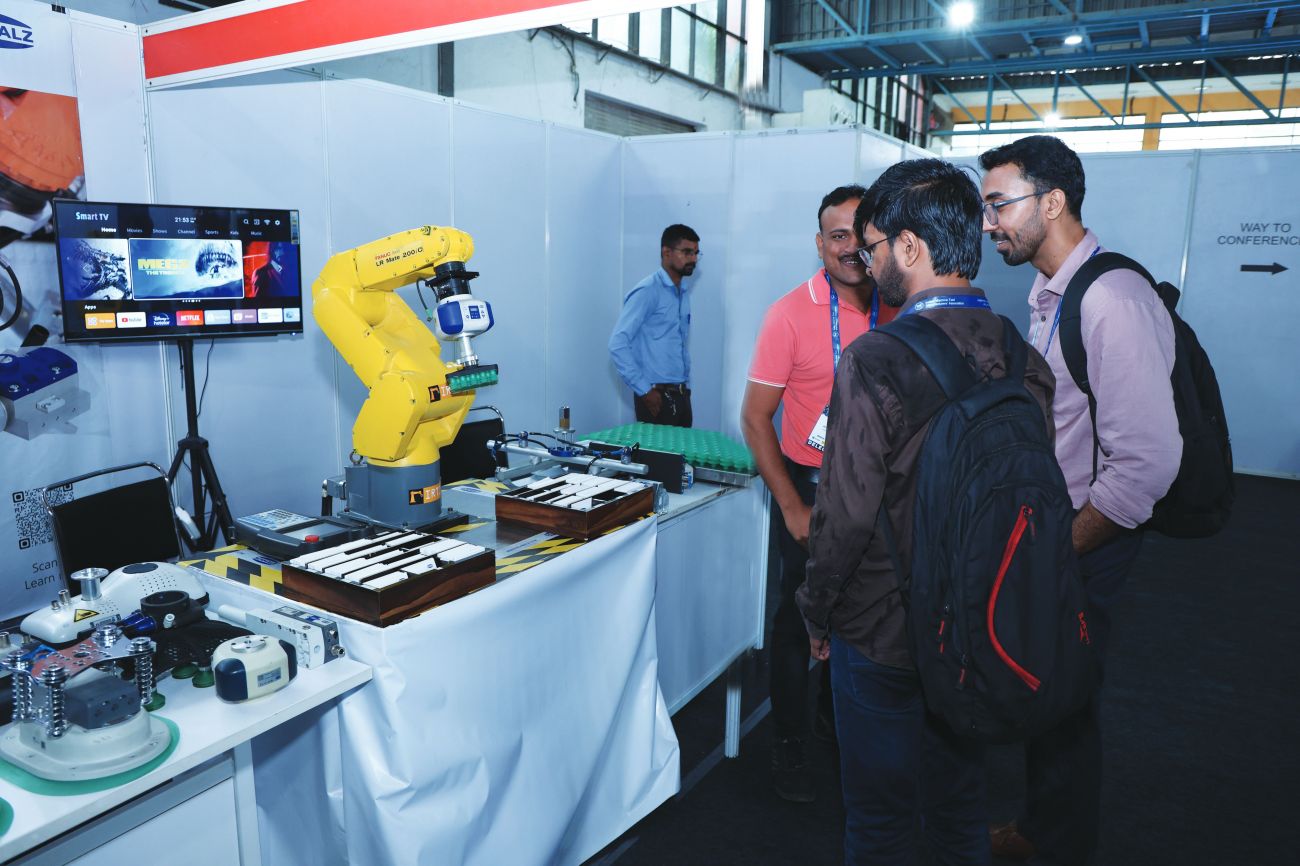TRANSFORMING INDIA’S MANUFACTURING LANDSCAPE

Organized by Indian Machine Tool Manufacturers’ Association (IMTMA), the 8th edition of Symposium on Automation and Robotics, held on June 4-5, 2025, was a power-packed event that brought together over 600 attendees eager to shape the future. Despite a heavy downpour, the enthusiasm of the participants and momentum of technological progress remained undeterred at Auto Cluster Exhibition Centre, Pune.
Themed ‘Trends & Insights for Tomorrow: Shaping the Future’, this year’s Symposium focused on emerging technologies while also issuing a call to action for India’s Manufacturing sector. OEMs, MSMEs, technology providers, academics, and policy stakeholders actively participated in technical sessions, observed live demonstrations, and explored strategic partnerships.
Making a notable appearance and presiding over the inauguration was Chief Guest Ashwin Shastri, Chief Transformation Officer, Tata Autocomp. The keynote speakers included Yuki Kita, Chief Executive Officer, FANUC India Pvt Ltd; Dr Asim Tewari, Professor (HAG), Indian Institute of Technology (IIT)-Bombay; and Rajesh Mandlik, Chairman, Regional Council West, IMTMA.
Jibak Dasgupta, Director General & CEO, IMTMA, noted, “The Symposium acts as an essential platform for sharing ideas and monitoring the latest trends shaping our industry.” He also added, “While countries like Germany and Japan have labor productivity levels nearing 95 percent or more, India still hovers around 70 percent. This gap is eroding the cost arbitrage advantage for India. To close this gap, we must adopt digital technologies along with investing in upskilling our workforce. Events like these are crucial in accelerating the adoption of Industry 4.0 and digitalization across manufacturing sectors.”
Echoing this sense of urgency, Mandlik shared statistics and urged industries to embrace robotics and automation as early as possible to remain competitive on the global stage. Dr Tewari added, “Digital isn’t the future anymore—it’s the present and is non-negotiable.”
Kita remarked on India’s growth prospects and on the adoption of automation and robotics and stressed how ‘robots improve safety, productivity, and quality and promote sustainable growth’. Shastri, in the session titled ‘Data the Heart of AI: Road Map for MSMEs for Complete Digitization’, advised MSMEs to ‘measure first and then automate’.
India Enters the Automation Age
A technical session on ‘India’s Automation Ascent: Scaling Potential to Performance’ by Ashim Sharma, Senior Partner & Business Unit Head, Business Performance Improvement (Auto, Engineering & Logistics), Nomura Research Institute Consulting and Solutions India Pvt Ltd, acknowledged challenges in the adoption of automation. “Organizations should consider a holistic view when assessing the types of tasks to automate, prioritizing maximum benefits while minimizing costs and risks,” suggested Sharma.
Precision Engineering & Modular Automation

Chua Yeong Tu ‘Mike’, Vice President, Application Engineering, Akribis Systems, in his session titled ‘Use of Direct Drive in Machines to Increase UPH & Precision,’ offered an insight into the use of Direct Drive Technology to enhance precision and increase Units Per Hour (UPH)—a critical productivity metric—in manufacturing. To measure this effectively, he emphasized the role of Overall Equipment Effectiveness (OEE), a composite score that evaluates availability, performance, and quality.
Venkatesan M, Associate Vice President & Business Head, Titan Engineering & Automation Ltd (TEAL), showcased Turnkey Assembly and Testing Solutions tailored for varied industries from EVs to med tech. “Where the processes demand high quality, we deploy robots. Where efficiency and flexibility is key, we opt for cobots,” he noted. “To make a machine smart for a smart factory, we need an integrated combination of hardware and software.”
Scalable Robotics and Additive Manufacturing
Marking Festo India’s centenary, Tapan Upadhyay, Head - Application Engineering, Business Region India, Festo India, spoke on ‘Reimagining Factories with Scalable Robotic Solutions and Flexible EOAT’ and introduced plug-and-play Cartesian robots. These robots require no coding and offer scalable palletizing solutions that can be quickly deployed and configured. In the area of End-of-Arm Tooling (EOAT), Upadhyay revealed that the company is furthering servo pneumatic systems powered by Piezo technology and concluded with a brief on Festo AX – Motion Insight Pneumatics.
In ‘Accelerating the Adoption of Additive Manufacturing in Smart Automation’, Mukesh Kumar, Deputy General Manager, Redington Ltd, highlighted how AM technology is evolving beyond its traditional role. Stressing on-demand manufacturing, he emphasized continuous improvization without investing in new tools. He called attention to the need for better cost evaluation, thoughtful selection, and a stronger focus on post-processing—steps that are often overlooked but critical to integrating AM into mainstream production.
Converging Technologies for Modern Manufacturing

A Panel Discussion ‘Convergence of Al, ML and IoT into Modern Manufacturing’ assembled leading names from the industry exploring the tech’s transformative power. Uday Narang, Founder, Omega Seiki Mobility, declared, “AI and IoT are the top investments for firms. Everyone — from large companies to MSMEs — will start adopting AI.”
Addressing MSME challenges, Upadhyay added, “For MSMEs to stay competitive globally, digitizing is the first step that requires long-term planning and measuring, as data is the heart of AI, ML, etc.” Zeroing in on ‘digitization or digitalization’, Kavita Kaushik, Head Quality and Six Sigma India Region, Cummins India, shared practical insights from digitizing shop floors, revealing, “Our machines’ OEE is now tracked online, helping us improve expense management and reduce downtime. The payback is faster than most expect.”
Striking a crucial balance between innovation and sustainability, Dr Ravindra Utgikar, Vice President, Wilo Group, emphasized, “Harnessing digital advancements is non-negotiable. Data is the foundation, and AI enables predictive maintenance that eliminates future costs.” Bringing the discussion full circle, A Ramasubramanian, Chief Technology Officer, Blue Energy Motors, summarized the evolution of data. He noted, “Today, there is Big Data, and our ability to handle it as humans is nil. However, by leveraging AI, we can analyze disparate data, build patterns, and bring in various solutions.”
Cobots, Quality, and India’s Readiness
‘Precision and Performance - Robotics in Next-Gen Manufacturing’ by Vishal Patil, Product Leader – Robot, Western Region, Mitsubishi Electric, was another standout session. Ajay Sable, Regional Head of Robot Sales, FANUC, delved into ‘Collaborative Robotics (Cobots) in Smart Factories’. “They’re smaller, cost-effective, easier to program, and safe—perfect for human-machine collaboration,” he said, citing FANUC’s CRX series.
Nitin Sinha, BDM - Asia & Middle East, Leuze Electronic Pvt Ltd, focused on sensor solutions, proving automation excellence begins with rock-solid safety. Cosimo Cereda, Sales Director, Marposs, championed quality assurance over control during his session on ‘Automated Inspection and Gauging’. “Quality isn’t automatic with machines. It’s proactive monitoring,” he stated, presenting Marposs’ GEMCPU solution—an intelligent module for zero-defect manufacturing.
| The symposium delved into India’s automation ascent, the use of direct drive in machines, cybersecurity, and scalable robotic solutions. |
Where Does India Stand?
A panel ‘The Future of Automation & Robotics — Where Does India Stand?’ industry comprised of Dr Sandhya Pande, Senior Director, Philips India Ltd; Rajeev Solanki, Head - Central Process Engineering, Legrand; Mahendra Patil, National Head-Robotics & Tech Support, FANUC India Pvt Ltd; Yash Sultania, Director - India, Akribis Systems; Sarvadnya Kulkarni, CEO, General Instruments Consortium; and Santosh Kulkarni, Vice President, Bajaj Auto Ltd.
Dr Pande emphasized, “Automation and robotics are essential if India is to compete globally, especially as we shift toward Industry 5.0.” Solanki spoke candidly about Legrand’s gradual automation journey and reminded the audience that automation doesn’t eliminate humans; it supports them and extends beyond the shopfloor to design and beyond.
Patil brought a data-backed and comparative perspective of the robots sold, placing India 7th globally, giving room for huge potential, especially if India accelerates its adoption across sectors. Clarifying that Machine Learning is more relevant for companies like his, Sultania pointed out that MSMEs are slowly adopting automation, particularly collaborative robots.
Sharing a personal perspective spanning three generations, Sarvadnya opined that MSMEs are more open to AI and highlighted the evolution from manual work to CNC to AI-driven systems. With insights from Santosh, who stressed the need to prioritize before adopting and shared Bajaj Auto Ltd’s sub-cluster approach, the panel concluded with a call for ‘appropriate automation’—flexible, scalable, and future-ready.
| The Symposium featured sessions on VR-based technologies, cobots, automated inspection and gauging, sustainable automation, and smart factory of Industry 4.0. |
A Blueprint for Change
In addition to sessions on Cybersecurity, VR-Based Factory Layout Planning, Sustainable Automation, and Smart Factory of Industry 4.0, the symposium also featured an exhibition area at the end of each day to bring into the spotlight advanced automation and robotics technologies. Innovations that support MSMEs were put into focus as the participants discussed partnership and pilot projects.
In line with IMTMA’s unwavering commitment to bolstering India’s Manufacturing industry, the 8th Symposium on Automation & Robotics stood as a wake-up call for India’s manufacturers to embrace intelligent automation as a way forward.
 |
Sovan Tudu |




 Facebook
Facebook.png) Twitter
Twitter Linkedin
Linkedin Subscribe
Subscribe